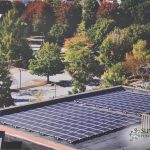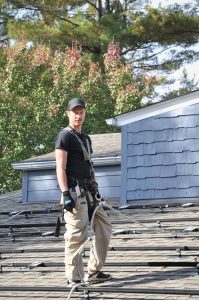GNT North America Goes Solar with Sundance!
GNT is a German company and the world leader in producing all-natural plant-based food coloring. They have added their new distribution warehouse in Dallas, North Carolina, just west of Charlotte. This is designed to handle distribution for the East Coast. This facility will eventually house a production area as well.
Natural Colors for the Food & Beverage Industry
The GNT website explains what they do:
“EXBERRY® is the leading brand of Coloring Foods for the food and beverage industry. Coloring Foods are made from fruits, vegetables, and edible plants using a physical manufacturing process processed with water. Founded over 45 years ago on the principle of coloring food with food, EXBERRY® has established itself as the leading brand of natural colors for the food and beverage industry.”
Components of This New Solar System
Sundance Vice President, Brian Hollister, worked on the design of this system. His final design utilized (574) Astronergy Astro 3 Twins Series 410-watt Bi-Facial Modules (aka solar panels), covering a good portion of the GNT facility’s roof. These modules are held down with a PanelClaw FR5 Ballasted Racking System. Two inverters are incorporated:
- (1) SolarEdge 120kW Synergy Inverter
- (1) SolarEdge 80kW Synergy Inverter
Sundance Designs & Installs Commercial Solar Systems
Sundance Power Systems has been ’empowering people with solar’ since 1995. Whether a system is designed for a homeowner, small business or larger facility such as GNT North America, Sundance has the expertise to handle the job. We love seeing these big warehouse buildings covered with solar panels. Oftentimes, these rooftops just bake in the sun as unused space. Adding solar is a win-win situation for the business and the planet!

Reuter Family YMCA adds solar power!
Sundance Power Systems recently completed a solar system at Reuter Family YMCA in Biltmore Park Town Square. The Reuter Y is “South Asheville’s fitness destination” and this system will generate 84 megawatt hours of electricity annually.
Here are the stats on the new system:
- (120) JA Solar Panels (or Modules), each rated at 535 watts
- (1) SolarEdge 100 kilowatt Inverter, oversized to leave plenty of room for system expansion
- Ballasted racking system
- Annual production rated at 84 kilowatt hours, or 84 megawatt hours
From the Reuter Y press release:
Reuter Family YMCA Flips the Switch to Solar Power Thanks to Generous Donor’s Contribution!
‘This installation allows the Y to take a significant step towards sustainability and demonstrates its commitment to environmental stewardship. By harnessing the power of the sun, the solar panels will provide clean and renewable energy to the facility, reducing its carbon footprint and contributing to a greener future.
Sundance Power Systems, known for its expertise in solar energy solutions, worked closely with the YMCA to ensure a seamless installation process. The long-term benefits will have an impact on the community for many years to come.
The YMCA of Western North Carolina‘s Reuter Family YMCA was able to put the sun to work for the facility through a generous donation from Pete and Pat Wallenborn. “As long-time YMCA members, we appreciate what the YMCA has done especially being all-inclusive. We hope to inspire others to invest in clean energy”, shared Wallenborn.’
Drone Footage of Solar System at Reuter YMCA:
Hanvey Engineering
Sundance Installs Second Solar System for Hanvey!
In April 2023, we installed a 81.85 kilowatt grid-tied PV (solar) system for the Hanvey Engineering company in Easley, SC. It is comprised of 153 JA solar panels, each rated at 535 watts and a SolarEdge 80kw inverter. This system will be cranking out clean electricity from the power of the sun for years to come!
Back in 2017, we installed a 37.95 kilowatt solar system comprised of 138 QCells solar panels paired with 3 inverters (2 SolarEdge and 1 Pika) for Hanvey. When Hanvey moved to their new location, also in Easley, they called Sundance to design a new solar electric system to meet their growing needs. Brian Hollister, our Director of Business Development, sold and designed both of these systems.
Here is some background on this innovative family business:
“Hanvey offers specialty tools and equipment built to streamline the pet grooming process alongside precision-engineered mobile grooming vans with the sleekest, most efficient designs and layouts in the industry. Curtis Hanvey, Jr expresses, “I have a way of finding what we call ‘The Hanvey Edge.’ Take outdated designs and make them do things that have not been done before within that technology. ‘The Edge’ always revolves around the theme of reducing some stress and strain or everyday hassle that causes a professional groomer to experience that well-known occasional burn-out cycle. The ‘Edge’ can put the fun back into the profession. Any groomer understands what I mean by burn-out. It was just too exciting to see my mom tell me, ‘I enjoy grooming!’ My designs made a dramatic improvement.”

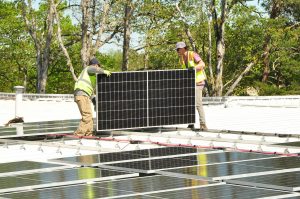

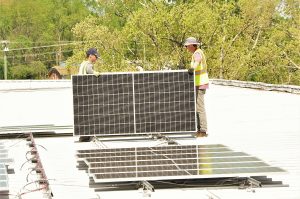



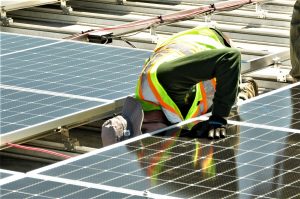
Sundance Power Systems designs, installs and services solar electric systems for homes, businesses, churches, schools and more. We have been empowering people with solar since 1995 and love being part of the move towards renewable energy throughout the Carolinas! Give us a call for a free quote or to refer a friend!
Check out this Short Video of Our Crew in Action at Hanvey!
This customer lives in North Asheville and wanted to go solar for several reasons. He drives an electric car and loves clean energy technology. Going solar to power the house was the next logical step! The house itself has a fairly strong solar window with good ‘irradiance’, a way of estimating the power a solar system will produce. He chose Sundance Power Systems because of our deep experience, plus he knew several Sundance staff members.

This Asheville solar power system is 12.41 kilowatts and is powered by 34 Qcell 365 watt panels on the roof. (In 2019, Qcells opened the largest solar assembly facility of its kind in the Western Hemisphere. The 300,000 square foot factory located in Dalton, Georgia outputs approximately 1.7GW of solar modules each year, equivalent to the peak output of the Hoover Dam!) The solar panels are each paired with a SolarEdge optimizer and they are attached to the roof with Ironridge racking, our high-quality standard system for anchoring the system securely. A SolarEdge inverter takes the direct current (DC) power from the panels and converts it to alternating current (AC). This solar system is projected to offset about 86% of annual electric consumption.

The solar power system was installed over a couple of lovely autumn days in October 2022. Sundance Power Systems is proud to serve the Asheville metro area as well as upstate South Carolina. With powerful Federal tax credits that were increased and extended by the Inflation Reduction Act of 2022, there has never been a better time to go solar. Sundance is 100% locally-owned with over 27 years of experience in designing, installing and servicing the systems we build. Get in touch for a free quote and take control of your energy future!
This 3.9 kilowatt system in central Asheville was installed in September 2021. 12 REC 325 solar panels (or modules) work to generate direct current (DC) from the sun. A SolarEdge 3800 inverter then converts that DC to alternating current (AC), allowing the power generated to be used in the home.
“Sundance has provided me with punctual and friendly service repeatedly. Many thanks to Matthew, Connor, Gretchen, and especially Travis for their time and continuing dedication to Sundance’s product and solar power in general.” Laura McKeithen, homeowner
This grid-tied photovoltaic system is 10.08kW and features 28 REC 360AA black-on-black modules, or solar panels. The Solar Edge 10kw inverter has a 25-year warranty extension. 28 Solar Edge optimizers each work with the modules/panels to maintain optimal output. Optimizers keep a module/panel working even if a cell gets covered by something, keeping the overall system up to speed. Sundance added a “self-consumption meter” as well. This device allows customers to apply for the Duke Energy rebate a second time if they are not chosen by Duke in their lottery the first time that they are eligible. The modules/panels also have a 25-year REC Pro Trust warranty. The racking is manufactured by Iron Ridge and is the highest rated system available for mounting a rooftop solar system.
Years of Organizing Culminates with the Installation of Community-Funded Solar Power System at ISAAC DICKSON ELEMENTARY SCHOOL
The much-anticipated solar electric system placing solar panels at an Asheville public school has been installed on the roof of Asheville’s Isaac Dickson Elementary School. In January of 2015, Sundance Power Systems was awarded the contract for the project which lacked the funding from Buncombe County to be completed with the initial school construction project. Thanks to a community fundraising campaign led by Sundance and the Green Built Alliance’s Appalachian Offsets program, the system was successfully funded and the project was completed in 2021.
Sundance has worked for 26 years to establish and promote renewable energy in the WNC region. Sundance strives to empower our communities through the adoption of renewable energy systems. Appalachian Offsets funds renewable-energy projects and energy-efficiency upgrades in Western North Carolina schools, nonprofits and low-income housing by pooling money contributed by local businesses and individuals through its voluntary carbon-offset program to install solar panels at an Asheville public school . This partnership has wielded success in developing the first truly community solar project in the region funded exclusively by local parents, teachers, concerned citizens, local philanthropists and the school system.
Appalachian Offsets finished fundraising for the Isaac Dickson solar project — its largest undertaking to date — in late 2019. (Check out this feature from them.) “It was critical to partner with Appalachian Offsets to fundraise for this project. Sam and the whole team at Green Built Alliance rallied to organize crucial community fundraising” says Dave Hollister, President of Sundance Power Systems. “Over two years, more than 100 donors contributed directly to make this project happen,” Green Built Alliance Executive Director Sam Ruark-Eastes said. “This was a collective effort and we couldn’t have done it without the support of our many donors who all reached deep into their pockets to fund this effort. We are so grateful to live in a place that values clean energy for schools.”

Isaac Dickson was designed as one of the state’s first Net Zero Energy schools and has been awaiting the solar system to help it move toward manifesting that vision since it was built in 2015. Following the recent approval of the long-awaited interconnection agreement from Duke Energy, the system was installed by Sundance Power Systems on the school’s roof. Work began in early March 2021 and completed in May 2021. The system has been producing beautiful clean power since June 2021!

The solar system at IDES is 300 kW photovoltaic array on several roofs with a total investment of $428,000. Appalachian Offsets and Sundance coordinated the fundraising efforts, collecting $305,000 through a variety of community contributions. The project is also being made possible through a $75,000 rebate from Duke Energy as well as Asheville City Schools’ allocation of $48,000 in energy-efficiency rebates it received for the energy-efficient construction of Isaac Dickson.
The solar array is a net-metered system, resulting in the school’s electric bill being lowered by more than $30,000 per year with a 30-year savings of more than $1.3 million, according to Sundance Power Systems. Through an agreement with Buncombe County, the money saved on Isaac Dickson’s electric bills is scheduled to go back into the school’s operating budget.
“The Isaac Dickson project is an expression of the dedication and commitment of this community for taking action against climate change and to leverage this technology to benefit our school system for years to come,” Sundance Power Systems President Dave Hollister said. “With the leadership of the Green Built Alliance and its Appalachian Offsets program, teachers and concerned citizens were able to raise the money for the project. This is community solar at its best.”

In addition to reducing the school’s energy bills, Isaac Dickson will leverage the asset as a teaching resource by weaving student involvement into the installation process and data from the on-site solar system into curriculum for students.
“Installing a rooftop solar system will fulfill the architects’ vision of using the school building itself as learning tool that can be used to facilitate discussions about our environment and conservation, as well as the impacts of fossil fuel consumption not just on our climate but also on our air and water quality,” said Isaac Dickson parent Matt Menne, who played an integral role in fundraising efforts during his time as co-president of the school’s PTO. “What better way to help than by reducing the carbon footprint of our schools, which provides the added benefit of saving money on energy costs for the district in the long run.”
Rooftop Array
- System Size: 300Kw
- Estimated Annual Production: Over 400 MWh
- PV Modules: (750) Hanwha Q.PEAK DUO L-G7.2 400
- Racking: Iron Ridge XR-10 racking and S-5-H90 clamps
- Inverters: (2) SolarEdge SE100KUS, (1) SolarEdge SE33.3K
- Monitoring: SolarEdge
- CO2 Offset: Public Kiosk View: https://monitoringpublic.solaredge.com/solaredge-web/p/kiosk?guid=26a0577e-7a50-4c41-8494-bf42edd4e15e
As of 8/2021:
CO2 Emission Saved: 77,964.36 lb
Equivalent Trees Planted: 589.09
Solar electric system fulfills lifelong dream! This 5.8 kW grid-tied solar electric system is a long-time dream of environmental activist Sherry Vaughan. Here’s Sherry’s inspiring story as she tells it:
“I have owned my home in Swannanoa for three years. High on my bucket list for home ownership has always been powering my home with the energy of the sun. 2 years ago I got an estimate from Sundance Power Systems to install roof top solar on my home. It was $2000 more in cost then than the estimate I got this year. Also, this year Duke Energy is offering a rebate for installing solar. Time to do it! In addition, I chose to move quickly before the impact of tariffs raised the cost of panels.
Sundance installed a 5.8 kW solar electric system with 20 solar panels (REC Solar 290W). My annual power usage is about 9000 kWh. My solar system will power 7479 kWh of that. I couldn’t be happier with my installation experience with Sundance Power Systems! My process was very smooth and on schedule. I was surprised how many people are involved in this process; from developing my proposal to permitting to project management to the solar panel installers to Duke installing a new meter box – my process seemed without challenge. My installers were so sweet and said some roofs have multiple pitches, causing installation challenges. My install was straight forward and quick, happening in 3 days. Some people prefer not to have their panels visible from the street. I would have welcomed showing off my panels from the street, but panel location is all about maximum sun exposure.
I am a proud environmental activist. Powering my home with solar meets my need to “walk my talk”. (Sherry’s system will offset approximately 5.6 metric tons of carbon dioxide (CO2) annually. That’s the equivalent of carbon sequestered by 6.6 acres of forest!) I’ve been a Green Granny who sings for the climate. I am a member of 2 environmental groups: 350.org, which we organized to march in Washington against the Keystone XL pipeline and Western North Carolina Renewables Coalition, or WNCRC. Currently we are working with Buncombe County and the City of Asheville writing a resolution to become 100% fossil free by 2050. I am also an avid veggie and flower gardener with beautiful sun flowers. My home displays many sun medallions that reflect my love and appreciation of the sun.
Together with Sundance Power Systems I celebrated my joy of becoming a solar powered home with a Solarbration near the Summer Solstice! My family, friends and neighbors enjoyed a lovely summer afternoon together with a Sundance tent and Erika and other Sundancers on hand to answer questions. I haven’t received any bills yet from Duke to measure cost savings, but my experience with Sundance has been delightful.”
Sherry’s delight is ours as well, as it is incredibly gratifying to see her become empowered with solar after all this time. We first met this amazing woman at least 5 years ago, when she would come out to Downtown After 5 and dance to solar-powered music, and share her enthusiasm for Sol’s energy as a solution to so many of our environmental and social challenges. Her passion is strong, and at least one of her friends that attended her Solarbration has been inspired to go solar as well. This is how we are becoming a clean energy community!
This 16.25 kw net-metered system with Duke Energy consists of 57 Sunmodule Plus 285 watt panels and SolarEdge DC Optimization Technology.
Robert Sipes of Duke Energy, and a Sundance customer, shares his solar story below:
“My wife Alison and I have moved 17 times since we were married 34 years ago. After we moved from Asheville to Raleigh in 2009 we agreed that we only had one more move left in us and that was back to Asheville where we’d ultimately retire. When the opportunity to move back presented itself we decided that the home we’d move into and hopefully spend the rest of our lives in, had to be everything we wanted, including environmentally friendly. We couldn’t find an existing home that met our needs so we decided to build. In 2014 our dream home was complete with one major exception – it didn’t have solar installed.
Alison and I believe strongly that we as a society have to transition to clean and sustainable forms of energy. In my job at Duke Energy, I’m responsible for what we call our Western Carolinas Modernization Project which involves working together with folks outside of the company to help make that transition happens in ways that don’t compromise the reliability or affordability of the electricity that our customers depend on. It’s a big challenge but one that I love and embrace. Installing solar on our house just made good sense to us as one of the ways we could/should personally support the change that has to occur.
One of the key factors in deciding on the lot we bought for our home was its suitability for solar. We found a great location that faces slightly east of due south, so everything from there fell neatly into place for the most part. We’ve had no regrets with our decision to install solar on our home. The only thing I’d think about doing differently would be to try and figure out a way to incorporate battery storage into the system. At the time, we just couldn’t make the economics work. Since then, the price of batteries has continued to drop and Duke Energy is working on ways to help offset the cost of batteries for home and business owners. I’m hoping that we’ll be able to start offering something sometime soon.
We have a 16 kW system and we almost produce as much electricity as we use. Our goal is to continue identifying ways we can be more efficient, so we can get to the point that we produce as much as we use. I’ve installed an energy monitoring system in our house, so I can track how we use energy and take steps to improve. Over the past couple of years, we’ve reduced our overall electricity use by around 12%. I’m very excited that in a few months Duke Energy will begin installing smart meters on every home and business in this area. These smart meters will give all of our customers a tool that they can use, very much like my energy monitoring system, so they can identify ways that they can be more efficient and save money!
Our system is virtually invisible, so people don’t know we have it unless we tell them. That said, once folks find out that we have solar their first comment is almost always “You work for Duke Energy and you have solar?” After I explain why we have it and how it works, they get really interested in how it can make sense for them. I’m very pleased that, hopefully, Duke Energy will begin offering incentives for roof top solar systems soon. When that happens, I think a lot of those people who’ve been on the fence about putting in a system will go ahead and take the plunge. Sundance and Duke Energy worked together with many other stakeholders from around the state to put together a program that should really help increase the number of roof top systems that are installed. We’re keeping our fingers crossed that the program gets approved very soon.”
Having Robert share his perspective on embracing solar at his home is very encouraging, and we take it as a great honor that he said “Sundance was great to work with. I began my career doing electrical construction work and still do some work for myself and friends. As a result, I have very high standards for the quality of work that is done. The quality of work that Sundance did EXCEEDED my expectations! Their techs were highly skilled and their attention to detail was amazing. They were also super easy to work with.” The sentiments are mutual, and we look forward to seeing Robert’s work in leading Duke Energy towards a new energy paradigm in our region.
System Specifications-
16.25 kW net-metered system with Duke Energy
– 57 SolarWorld’s Sunmodule Plus 285 watt monocrystalline solar panels
– Flush mount Power Rail by Preformed Line Products
– SolarEdge’s residential DC Optimization technology and monitoring
The annual production for this system was estimated to be 19.4 megawatt hours, but SolarEdge’s monitoring platform shows that this has been exceeded with 21.7 and 20.7 MWhs produced in 2016 and 20.7 respectively. Since its installation at the end of 2015 the system has produced 44.61 MWhs of electricity, which has the environmental benefits of 1,740 trees planted!
____________
Professional Bio (2015)
Robert Sipes is the vice-president of the Western Carolinas Modernization initiative for Duke Energy. In that role, Robert is responsible for leading Duke Energy’s efforts to transform the way electricity is produced, distributed, and used in western NC. A significant part of Robert’s work includes his involvement in the Energy Innovation Task Force whose members include a diverse cross section of community leaders. It was formed through a partnership between the City of Asheville, Buncombe County, and Duke Energy. The work of the task force is focused on driving solutions to today’s electric energy related challenges through collaboration and partnership. Later this spring the task force will be launching its Blue Horizons campaign to raise awareness and drive action by all of the residents of Asheville and Buncombe County to achieve the cleaner, smarter, and affordable energy future that we all desire.
Sierra Nevada Brewing Co.’s state-of the-art brewery in Mills River, NC demonstrates several leading-edge sustainability measures, including on- site solar electric generation. With a combined capacity of 710 kilowatts DC, two separate photovoltaic systems produce a significant amount of the electricity used in their operations. The rooftop array covers nearly two acres on the facility’s packing and warehouse, while nine parking lot canopies are strikingly visible to the public. They also provide shading, reducing the heat island effect, and enhancing the experience for visitors.
Rooftop Array
- System Size: 650 kW DC
- Estimated Annual Production: 852,857 kWh
- PV Modules: (2,030) Kyocera 320W Modules
- Racking: Daetwyler Eco-Top Mounting System
- Inverters: Solectria (1) 250 kW, (1) 300 kW
- Monitoring: Deck (string level)
- CO2 Offset: 588 metric tons
Parking Lot Canopies
- System Size: 60 kW DC
- Estimated Annual Production: 50,053 kWh
- PV Modules: (198) Suniva 305 watt modules
- Racking: Custom design
- Inverters: Solectria (1) 50 kW
- Monitoring: Deck (zone level)
- CO2 Offset: 5 metric tons
Sierra Nevada Brewing chose Asheville, NC as the location for their East Coast brewery and they deserve three big cheers for arriving here with an impressive suite of strong values and high standards. These values are manifest in their collaborative efforts, community-mindedness, and commitment to sustainability. Founder Ken Grossman was quoted early on in the process saying “For years, we’ve considered a second brewing location. The recent growth of craft beer in the eastern USA, combined with the environmental impact of shipping all the way across the country, made a second brewing location the most sustainable solution for us moving forward. In North Carolina, we were humbled by the community, its values and the outstanding craft beer culture in the area… Mills River and the Asheville area feel like a great fit for us; a close-knit community with outstanding quality of life, shared values and access to the outdoors.” Considering they reviewed over 200 sites, being selected for the home to their expansion speaks to WNC’s strengths and resources.
Asheville has long been recognized as a mecca for craft beer, with one of the highest numbers of breweries per capita anywhere in the United States. The Asheville Brewers Alliance, true to its mission to “promote regionally produced beers and exchange knowledge and support between our members for the betterment and enrichment of the beer community” welcomed Sierra Nevada, forging a win-win collaborative relationship, rather than a competitive one. While a thriving market made this area a strong choice, the allure of WNC’s mountains and natural resources, especially clean water, a critical element to making quality beer, were also paramount in the siting decision. Much of the site’s 180 acres bordering the French Broad River are being revitalized with hiking trails, garden spaces and river access, creating a hub for outdoor recreation that has always been close to the heart of Sierra Nevada.
A strong environmental ethos, along with a creative, innovate spirit to make the most out of everything, led the development of Sierra Nevada Brewing Co. since being founded in 1980 in Chico, California. The company’s commitment to sustainability has been a cornerstone of their success, and they’ve raised the bar on many levels. Their 2012 Sustainability Report is an impressive account of their efforts to “maintain a healthy balance between environmental stewardship, social equity, and economic stability,” and is specifically aimed at three main goals: promote zero waste action, increase work space efficiencies, and lead by example to inspire change. Their basic approach “is to close the loop” wherever and whenever possible. “We look for opportunities to bring materials leaving our facility – such as heat, water, and packaging – back into our production process.”
Apparently, nothing escapes the scrutiny of the Sustainability Department in Chico, as Sierra Nevada received Platinum Zero Waste Certification from the US Zero Waste Business Council, making them the first company ever to reach that status. An audit showed that 99.8 percent of its waste was successfully diverted, often becoming a valuable resource for another process in their operations. Scraps from the restaurant are composted for use in the gardens, while waste vegetable oil is converted into biodiesel on site and used in their truck fleet. Spent grain, hops and yeast are fed to cattle on local farms, including Sierra Nevada’s own herd. Biogas from the wastewater treatment plant is captured and used to fuel the boilers. They even go so far as to recover Carbon Dioxide from the fermentation tanks, and use it for pressurizing and moving beer through pipes and in bottling it.
Energy is also approached with uber-efficiency at Sierra Nevada, and heat recovery units on boilers, fuel cells, and brew kettles reclaim waste heat, rather than venting it. Of course, they also soak up the solar energy spilling on their site, with one of the largest privately owned solar systems in the country. Two megawatts of capacity, between several arrays, including one on their rail spur, generate nearly 20 % of the electricity used at the site.
Expanding upon this strong legacy of sustainability established over years of continually striving to do better, the new brewery is poised to model leading edge technology and operations. “Our team is eager to apply lessons learned in Chico as well as new thinking to our North Carolina brewery,” stated Ken Grossman. Their stated goal is to earn a minimum of silver leadership in Energy and Environmental Design (LEED) certification, but when it is said and done Gold or even Platinum level wouldn’t come as a surprise.
The inclusion of on-site solar generation will contribute to this goal, and Sundance was extremely proud to be awarded the contract for the installations. Sierra Nevada committed to work with local vendors, suppliers, and installers, and this is also valued in the LEED ratings. Cheri Chastain, Sustainability Manager said of the system “Integrating renewable energy into our Mills River facility was an important part of our project design. Mirroring our Chico, California brewery’s diverse approach to renewable energy, we decided to couple biogas powered microturbines with photovoltaic technology in North Carolina. Sundance Power Systems designed and installed our 710 kW solar system which covers a warehouse roof and features canopies in our parking lot. We are looking forward to enjoying many years of renewable energy from the system.”
The 650 KW rooftop system consists of over two thousand 320 watt photovoltaic modules manufactured by Kyocera. This array expands over nearly two acres on top of the packing hall and warehouse. Daetwyler’s Eco-Top Rooftop Mounting System with Built-In Wire Management uses durable recycled rubber ballast pads to protect the integrity the roof, and is manufactured regionally in NC. Two Solectria inverters (250 and 300 kW) prepare the electricity for interconnection with Duke Energy, and production is monitored through a Deck package. The parking lot canopy system, with a collective capacity of 62 kW, is made up of nine umbrella-like canopies, each fitted with twenty-two 315 watt modules. A 50 watt Solectria inverter connects this system to the grid. These canopies are strikingly visible to visitors and provide cool shading in the parking lot, reducing the heat island effect.
Sundance Power Systems is honored to have been selected for this landmark project. We take pride in helping Sierra Nevada Brewing achieve their renewable energy goals and hope that more companies follow their example of sustainability and community engagement!
Asheville Family Fitness
A 40 kW net-metered system powers 80% of this LEED-certified building. As featured in our September 2018 Newsletter: The Vision and Mission of Asheville Family Fitness is all about positivity,...

 / Read More /
/ Read More /
Asheville Family Fitness
A 40 kW net-metered system powers 80% of this LEED-certified building. As featured in our September 2018 Newsletter: The Vision and Mission of Asheville Family Fitness is all about positivity,...

 / Read More /
/ Read More /
Asheville Family Fitness
A 40 kW net-metered system powers 80% of this LEED-certified building. As featured in our September 2018 Newsletter: The Vision and Mission of Asheville Family Fitness is all about positivity,...

 / Read More /
/ Read More /
Asheville Family Fitness
A 40 kW net-metered system powers 80% of this LEED-certified building. As featured in our September 2018 Newsletter: The Vision and Mission of Asheville Family Fitness is all about positivity,...

 / Read More /
/ Read More /
Why Partner with Sundance Power Systems?
Our 5 step design process sets the standard
Our Renewable Energy Consultants are not high-pressure sales people offering poorly constructed solutions and pipe-dream financing options. Our 5 Step Process is based upon listening to our customers and designing systems that empower a clean energy lifestyle.



























